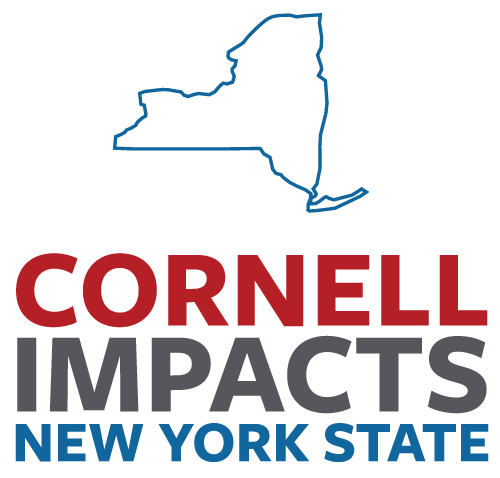As a veterinarian, Sabine Mann, Ph.D. '16, had frequently wished for a simple, accurate, affordable test that could assess inflammation in dairy cow herds. Once inflammation becomes severe enough to cause disease, like mastitis in the mammary glands or metritis in the uterus, animals suffer and farmers lose money. Catch lower-level or chronic inflammation earlier would help keep animals healthy and farms productive.
So Mann, an associate professor in the department of Population Medicine and Diagnostic Sciences in the College of Veterinary Medicine, joined forces with two colleagues to create the tests she needs. Over the past seven years, they have developed an assay that can detect three different cytokines - proteins that regulate immune response in cows and are more abundant in samples when inflammation is present. Now the team is working to expand the panel to include chemokines, proteins that control cell trafficking and direct white blood cells to areas with infected or damaged tissue.
"Cows with excessive, chronic inflammation produce less milk; they may not be able to reproduce as quickly, or they may be more susceptible to disease," Mann said. "So this kind of undiagnosed inflammation can lead to less efficient and less sustainable dairy farms and less milk in our food supply. We want to be able to detect inflammation before we even have a disease diagnosis - that's the time where we think we have the most potential for improvement, at a herd level."
She's working with two experts familiar with the problem.
Dr. Bettina Wagner, the James Law Professor of Immunology in Population Medicine and Diagnostic Sciences, had built panels like this before. She led the team that developed Lyme disease tests for horses and dogs, and she had developed similar inflammatory marker panels for horses. Dr. Anja Sipka, assistant professor of practice in the same department, specializes in bovine immune regulation, with a particular interest in identifying what types or levels of inflammation in dairy cows are normal versus problematic.
"Think of it like a blood test you would get at the doctor's office, where certain markers that are out of range indicate that something is not normal," Wagner said. "That's what we're trying to do - create a screening tool that points in certain directions so the vet is provided with a set of biomarkers that can be correlated to certain diseases in cattle."
These inflammatory diagnostic panels are not yet available to veterinarians, but that is the researchers' ultimate goal. For now, they are offering the tests to their colleagues through Cornell's Animal Health Diagnostic Center for clinical research. And they're trying to identify which inflammatory markers are associated with outcomes that matter to dairy farmers, such as lowered milk production, poor health or reproductive challenges.
The team anticipates veterinarians would use these tools to assess herds and reveal hidden problems, Mann said. "Then the next step would be: What could I do to mitigate these problems? What can we change in the way we're managing this herd? Try something, change something, and then measure these outcomes again to see whether herd health has improved."
Some inflammation is necessary and helpful to protect cows from disease. But certain cows, like certain humans, have an inflammatory response that "overshoots" and causes more harm than good, Sipka said. Another goal for this research is to understand what makes some cows more susceptible to such a response - and cytokines seem to be key.
"Inflammation is a signal that comes out from the immune system, like a radio broadcast, and cytokines' role is to turn the volume of that signal up and down," she said.
Similarly, chemokines, like the dial on a radio tuning to the right frequency, tells the immune system where help is needed to fight the disease.
The research has been supported by federal funding administered through the Cornell University Agricultural Experiment Station (Cornell AES). For almost 140 years, Cornell AES has distributed funding that Congress appropriated through the federal Hatch Act of 1887, to assist land-grant universities in aiding farmers and protecting the nation's food supply. The U.S. Department of Agriculture's National Institute of Food and Agriculture funded the development of immunological reagents that enable these tests. And facilities and staff at the Animal Health Diagnostic Center, which is funded in part by New York state, have also been critical in the researchers' success so far, Wagner said.
"Federal funding is instrumental in understanding basic science like this," Sipka said. "Pharmaceutical companies and other private funders just do not have the scope to fund something that is not directly going into a product. But these questions need to be answered, because how can you develop a product if you don't have the basic tools?"
The Lyme disease panel that Wagner's team released in 2011 also required many years of basic science; now the panel has benefited millions of dogs and horses.
"That kind of impact is the rewarding part for the years of work that have come before," Wagner said.
The team is working toward understanding how they can keep animals safe, healthy and in good welfare conditions, Mann said. But the impact goes far beyond healthy animals.
"Animal health also impacts dairy sustainability, because keeping animals healthy and productive contributes to the food supply," she said, "and it improves the rural livelihoods of farmers. Our focus is always on the people and on the animals."
Krisy Gashler is a freelance writer for the Cornell University Agricultural Experiment Station.







